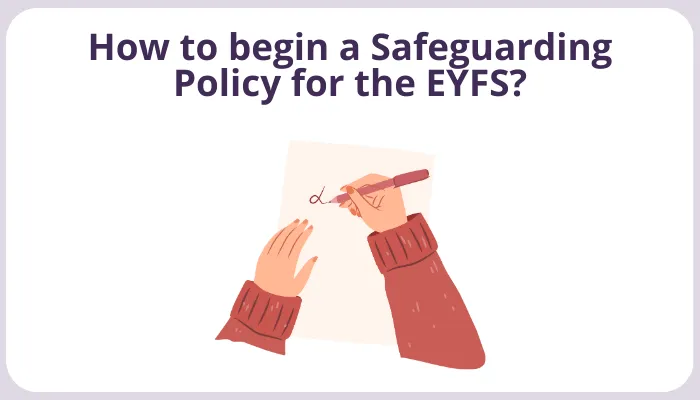Every child's well-being matters.
Best Practice Ideas for Safeguarding Articles
Quick Access

How to begin a Safeguarding Policy for the EYFS
An Early Years Safeguarding Policy is a crucial document that outlines the procedures and measures in place to ensure the well-being and safety of children in early years settings. While the specific details may vary based on the context and legal requirements, here are key elements that should be included in an Early Years Safeguarding Policy:
Statement of Intent:
Clearly articulate the commitment of the early years setting to safeguarding and promoting the welfare of children.
Emphasise the priority given to the well-being and safety of all children.
Legal and Regulatory Framework:
Provide an overview of the relevant legal and regulatory frameworks, including references to the Children Act 1989 and 2004, and other relevant legislation.
Ensure compliance with the Early Years Foundation Stage (EYFS) framework or any other applicable standards.
Roles and Responsibilities:
Define the roles and responsibilities of staff members, including the designated safeguarding lead (DSL), other staff, and volunteers.
Clearly outline the responsibilities of the manager or owner in ensuring that safeguarding procedures are followed.
Designated Safeguarding Lead (DSL):
Specify the role and responsibilities of the DSL, including their duty to liaise with external agencies and act as a point of contact for any safeguarding concerns.
Include information on the DSL's training and the process for updating their knowledge regularly.
Recruitment and Training:
Outline the procedures for safe recruitment, including the use of background checks and reference checks for all staff and volunteers.
Detail the training requirements for staff on safeguarding matters and how often refresher training will be provided.
Child Protection Procedures:
Clearly define the procedures for recognising and responding to signs of abuse or neglect.
Include steps to take if a staff member has concerns about a child's well-being, including reporting procedures and contact details for relevant authorities.
Confidentiality:
Emphasise the importance of confidentiality in safeguarding matters.
Clarify the circumstances under which information may be shared and with whom, ensuring that the best interests of the child are the primary consideration.
Recording and Reporting:
Outline the procedures for recording and reporting safeguarding concerns.
Specify the forms and formats for documenting incidents and concerns and the appropriate authorities to report to.
Partnership with Parents and Carers:
Describe how the early years setting will communicate with parents and carers about safeguarding procedures.
Encourage open communication and partnership, emphasising the shared responsibility for the welfare of the child.
Training for Parents and Carers:
Offer information and resources to parents and carers on safeguarding matters, including signs of abuse and the setting's procedures.
Review and Revision:
Specify how often the policy will be reviewed and updated, ensuring that it remains current and in compliance with any changes in legislation or best practices.
It's important to tailor the safeguarding policy to the specific context of the early years setting and to ensure that all staff members are familiar with its contents. Regular training and communication about the policy are essential to maintaining a safe and secure environment for children.
AUTHOR:- Iona has nearly 10 years of experience supporting nurseries and childminders in curriculum planning, leadership, and safeguarding. Her writing is informed by public information and sector insight, aiming to provide accessible, practical support for professionals working with children. She is part of the On the Button team, helping deliver Well-being, Safeguarding and Complaint Management Software that empowers practitioners to identify concerns early and act confidently.
On the Button provides innovative software tailored to the needs of the early years sector, with a strong focus on EYFS well-being and early years safeguarding. Our tools help senior practitioners to confidently track concerns, maintain robust records, and respond effectively — all while meeting statutory guidance. From early years complaint management to team-wide safeguarding alerts, our platform puts children's safety and emotional health first.
Quick Access

How to begin a Safeguarding Policy for the EYFS
An Early Years Safeguarding Policy is a crucial document that outlines the procedures and measures in place to ensure the well-being and safety of children in early years settings. While the specific details may vary based on the context and legal requirements, here are key elements that should be included in an Early Years Safeguarding Policy:
Statement of Intent:
Clearly articulate the commitment of the early years setting to safeguarding and promoting the welfare of children.
Emphasise the priority given to the well-being and safety of all children.
Legal and Regulatory Framework:
Provide an overview of the relevant legal and regulatory frameworks, including references to the Children Act 1989 and 2004, and other relevant legislation.
Ensure compliance with the Early Years Foundation Stage (EYFS) framework or any other applicable standards.
Roles and Responsibilities:
Define the roles and responsibilities of staff members, including the designated safeguarding lead (DSL), other staff, and volunteers.
Clearly outline the responsibilities of the manager or owner in ensuring that safeguarding procedures are followed.
Designated Safeguarding Lead (DSL):
Specify the role and responsibilities of the DSL, including their duty to liaise with external agencies and act as a point of contact for any safeguarding concerns.
Include information on the DSL's training and the process for updating their knowledge regularly.
Recruitment and Training:
Outline the procedures for safe recruitment, including the use of background checks and reference checks for all staff and volunteers.
Detail the training requirements for staff on safeguarding matters and how often refresher training will be provided.
Child Protection Procedures:
Clearly define the procedures for recognising and responding to signs of abuse or neglect.
Include steps to take if a staff member has concerns about a child's well-being, including reporting procedures and contact details for relevant authorities.
Confidentiality:
Emphasise the importance of confidentiality in safeguarding matters.
Clarify the circumstances under which information may be shared and with whom, ensuring that the best interests of the child are the primary consideration.
Recording and Reporting:
Outline the procedures for recording and reporting safeguarding concerns.
Specify the forms and formats for documenting incidents and concerns and the appropriate authorities to report to.
Partnership with Parents and Carers:
Describe how the early years setting will communicate with parents and carers about safeguarding procedures.
Encourage open communication and partnership, emphasising the shared responsibility for the welfare of the child.
Training for Parents and Carers:
Offer information and resources to parents and carers on safeguarding matters, including signs of abuse and the setting's procedures.
Review and Revision:
Specify how often the policy will be reviewed and updated, ensuring that it remains current and in compliance with any changes in legislation or best practices.
It's important to tailor the safeguarding policy to the specific context of the early years setting and to ensure that all staff members are familiar with its contents. Regular training and communication about the policy are essential to maintaining a safe and secure environment for children.
AUTHOR:- Iona has nearly 10 years of experience supporting nurseries and childminders in curriculum planning, leadership, and safeguarding. Her writing is informed by public information and sector insight, aiming to provide accessible, practical support for professionals working with children. She is part of the On the Button team, helping deliver Well-being, Safeguarding and Complaint Management Software that empowers practitioners to identify concerns early and act confidently.
On the Button provides innovative software tailored to the needs of the early years sector, with a strong focus on EYFS well-being and early years safeguarding. Our tools help senior practitioners to confidently track concerns, maintain robust records, and respond effectively — all while meeting statutory guidance. From early years complaint management to team-wide safeguarding alerts, our platform puts children's safety and emotional health first.

How to begin a Safeguarding Policy for the EYFS
An Early Years Safeguarding Policy is a crucial document that outlines the procedures and measures in place to ensure the well-being and safety of children in early years settings. While the specific details may vary based on the context and legal requirements, here are key elements that should be included in an Early Years Safeguarding Policy:
Statement of Intent:
Clearly articulate the commitment of the early years setting to safeguarding and promoting the welfare of children.
Emphasise the priority given to the well-being and safety of all children.
Legal and Regulatory Framework:
Provide an overview of the relevant legal and regulatory frameworks, including references to the Children Act 1989 and 2004, and other relevant legislation.
Ensure compliance with the Early Years Foundation Stage (EYFS) framework or any other applicable standards.
Roles and Responsibilities:
Define the roles and responsibilities of staff members, including the designated safeguarding lead (DSL), other staff, and volunteers.
Clearly outline the responsibilities of the manager or owner in ensuring that safeguarding procedures are followed.
Designated Safeguarding Lead (DSL):
Specify the role and responsibilities of the DSL, including their duty to liaise with external agencies and act as a point of contact for any safeguarding concerns.
Include information on the DSL's training and the process for updating their knowledge regularly.
Recruitment and Training:
Outline the procedures for safe recruitment, including the use of background checks and reference checks for all staff and volunteers.
Detail the training requirements for staff on safeguarding matters and how often refresher training will be provided.
Child Protection Procedures:
Clearly define the procedures for recognising and responding to signs of abuse or neglect.
Include steps to take if a staff member has concerns about a child's well-being, including reporting procedures and contact details for relevant authorities.
Confidentiality:
Emphasise the importance of confidentiality in safeguarding matters.
Clarify the circumstances under which information may be shared and with whom, ensuring that the best interests of the child are the primary consideration.
Recording and Reporting:
Outline the procedures for recording and reporting safeguarding concerns.
Specify the forms and formats for documenting incidents and concerns and the appropriate authorities to report to.
Partnership with Parents and Carers:
Describe how the early years setting will communicate with parents and carers about safeguarding procedures.
Encourage open communication and partnership, emphasising the shared responsibility for the welfare of the child.
Training for Parents and Carers:
Offer information and resources to parents and carers on safeguarding matters, including signs of abuse and the setting's procedures.
Review and Revision:
Specify how often the policy will be reviewed and updated, ensuring that it remains current and in compliance with any changes in legislation or best practices.
It's important to tailor the safeguarding policy to the specific context of the early years setting and to ensure that all staff members are familiar with its contents. Regular training and communication about the policy are essential to maintaining a safe and secure environment for children.
AUTHOR:- Iona has nearly 10 years of experience supporting nurseries and childminders in curriculum planning, leadership, and safeguarding. Her writing is informed by public information and sector insight, aiming to provide accessible, practical support for professionals working with children. She is part of the On the Button team, helping deliver Well-being, Safeguarding and Complaint Management Software that empowers practitioners to identify concerns early and act confidently.
On the Button provides innovative software tailored to the needs of the early years sector, with a strong focus on EYFS well-being and early years safeguarding. Our tools help senior practitioners to confidently track concerns, maintain robust records, and respond effectively — all while meeting statutory guidance. From early years complaint management to team-wide safeguarding alerts, our platform puts children's safety and emotional health first.
Quality Early Years Ltd.,
Dickens House,
Guithavon Street,
Witham, Essex,
England, CM8 1BJ
© Quality Early Years Ltd 2025
On the Button are Finalists for 3/3 Early Years Awards!
Find On the Button
on Social Media

